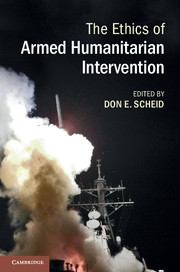Book contents
- Frontmatter
- Contents
- Notes on contributors
- Preface and acknowledgments
- List of abbreviations and acronyms
- Part I Intervention and debate
- 1 Introduction to armed humanitarian intervention
- 2 Revisiting armed humanitarian intervention
- 3 The responsibility to protect and the war in Libya
- Part II Moral perspectives
- Part III Ideas and reconsiderations
- Select bibliography
- Index
- References
1 - Introduction to armed humanitarian intervention
Published online by Cambridge University Press: 05 June 2014
- Frontmatter
- Contents
- Notes on contributors
- Preface and acknowledgments
- List of abbreviations and acronyms
- Part I Intervention and debate
- 1 Introduction to armed humanitarian intervention
- 2 Revisiting armed humanitarian intervention
- 3 The responsibility to protect and the war in Libya
- Part II Moral perspectives
- Part III Ideas and reconsiderations
- Select bibliography
- Index
- References
Summary
The chapters in this volume address normative issues concerning military interventions for humanitarian purposes. The modern debate about such interventions moved to a high point in the 1990s with a series of interventions and non-interventions, including Somalia (1993), Rwanda (1994), Srebrenica/Bosnia (1995), and Kosovo (1999). This debate led to the development of a promising doctrine called “Responsibility to Protect” (RtoP). The RtoP rationale was implemented in 2011 when the UN Security Council approved military intervention in Libya, and this intervention again spurred debates about armed humanitarian interventions. The intervention in Libya provides the reference point for many of the chapters in the present collection.
Terminology and the concept of armed humanitarian intervention
The phrase “armed humanitarian intervention” (AHI) denotes a military intervention into the jurisdiction of a state by outside forces for humanitarian purposes. The humanitarian goal is to protect or rescue innocent people (i.e., non-combatants) from ongoing or imminent, grave, and massive human-rights violations – that is, from mass atrocities. The rationale is not punishment for past wrongs, but prevention. The intervention is conceived to be a last resort for averting or stopping atrocities such as genocide, crimes against humanity, or mass expulsions.
Keywords
- Type
- Chapter
- Information
- The Ethics of Armed Humanitarian Intervention , pp. 3 - 25Publisher: Cambridge University PressPrint publication year: 2014
References
- 2
- Cited by

